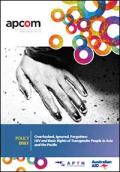Publications - Released in 2013
Transgender people are an integral part of the traditional culture of many countries in Asia and the Pacific and in many places have been accepted into traditional daily life. In September 2012, a regional meeting of transgender advisers and activists adopted a working definition for transgender people in the Asia Pacific context. The adopted definition states that transgender people are: “Persons who identify themselves in a different gender rather than that assigned to them at birth” and may choose to “express their identity differently to that expected of the gender role assigned to them at birth.” Transgender people in the region “often identify themselves in ways that are locally, socially, culturally, religiously, or spiritually defined,” using local terminology and indigenous labels, despite these terms often being derogatory and marginalizing. A report in 2012 documented 50 such different terms for transgender people across 16 countries.
However, acceptance and integration of transgender women and, to a lesser-documented extent, transgender men, into the daily fabric of local community life has diminished in recent times. Many assert that this change has been influenced by ‘western’ ideals. Societal acceptance and support of gender identification and varied sexual orientation has been declining, which is resulting in heightened discrimination of transgender people. Cultural and economic influences from the west have brought stigma, prejudice and discrimination towards those in Asia and the Pacific region who are transgender, along with men who have sex with men (MSM) and women who have sex with women.
Downloads
Organizations
- Asia Pacific Transgender Network
- Asia Pacific Coalition on Male Sexual Health (APCOM)






